2. 中国科学院大学,北京 100049;
3. 河南理工大学资源环境学院,焦作 454000
2. University of Chinese Academy of Sciences, Beijing 100049, China;
3. Institute of Resources and Environment, Henan Polytechnic University, Jiaozuo 454000, China
玄武岩来源于地幔,其化学成分和同位素组成既可以反映复杂的岩浆演化过程,也可反映源区地幔组成的多样性,是人类认识地球深部的重要窗口。大洋玄武岩因其受地壳改造作用小,成分上更接近原始岩浆,因而很早就受到岩石学家和地球化学家的关注(Zindler and Hart, 1986; Sun and McDonough, 1989; Hofmann, 1997),成为研究大洋地幔的主要途径。与大洋玄武岩相比,大陆玄武岩成分复杂,巨厚的大陆岩石圈(40~200km) 使其原始岩浆很容易受到改造而失去某些地幔源区的信息。大陆碱性玄武岩是大陆玄武岩中比较特殊的岩石类型,该类岩石通常产生于板内拉张或裂谷环境,母岩浆成分贫SiO2,富含挥发组分,在岩石圈中的岩浆上升、运移速度快,遭受围岩混染相对较小,其成分特征可接近于原始岩浆成分,加之其常捕掳大量地幔岩石和地壳岩石包体,因而成为研究大陆岩石圈及其下部地幔的主要对象(Farmer, 2003)。同时,大陆碱性玄武岩较小的岩浆规模及火山岩的不易保留性也使得对已发现岩石的研究意义变的更加重要。
华北克拉通东部自显生宙以来遭受了强烈的去克拉通化作用,岩石圈地幔的性质发生了巨大改变(Menzies et al., 1993; Griffin et al., 1998; Fan et al., 2000; Yang et al., 2008)。华北东部广泛发育的中、新生代板内玄武岩浆作用为研究该地区的岩石圈地幔性质和演化提供了天然的地质样品。过去几十年,国内外的学者对此开展了大量的研究,提出了不同成因模型和地幔源区(Liu et al., 1983; Fan and Hooper, 1991; Liu et al., 1994; Chung, 1999; Zhang et al., 2002; Tang et al., 2006; 徐义刚,2006; 汤艳杰等,2006; Xu, 2007; Ho et al., 2011; Yarmolyuk et al., 2011)。相对于东部地区,位于太行山东侧的鹤壁地区新生代玄武岩的研究甚少,缺乏系统的地球化学及岩石成因研究,已有的研究多集中在地幔橄榄岩包体上(Zheng et al., 2001, 2007; 赵新苗等,2007; 樊祺诚和隋建立,2009;Liu et al., 2011; Tang et al., 2011, 2012; Sun et al., 2012)。本文拟通过研究鹤壁玄武岩的地球化学特征来探讨其岩石成因及该地区新生代地幔源区特征,并对该地区新生代玄武岩的形成机制给出可能的解释。
2 地质背景与岩石学特征华北克拉通是世界上古老克拉通之一(Jahn et al., 1987; Liu et al., 1992),也是我国东部最为重要的地质构造单元(图 1a)。它由东西部陆块在~1.85Ga时碰撞拼合、克拉通化而形成(Zhao et al., 2001)(图 1b),但自显生宙,尤其是中生代以来发生了去克拉通化(Yang et al., 2008, 2010a),并伴随着强烈的岩浆活动、构造变形、成矿作用和盆地形成。新生代以来,华北东部岩浆作用以玄武质为主,岩石类型主要为碱性玄武岩和橄榄拉斑玄武岩,与分布在中国东北、东部沿海地区共同组成中国东部新生代玄武岩分布区(Zhou and Armstrong, 1982; 刘若新, 1992;Zou et al., 2000)。太行山位于南北重力梯度带中段,中生代以来发育有近NNE向的断裂带(Ye et al., 1987; Gilder et al., 1991),沿断裂带广泛分布新生代玄武岩。研究区位于太行山东南缘的河南鹤壁,区内新生代玄武岩含有大量地幔橄榄岩捕掳体(樊祺诚和刘若新, 1994;Zheng et al., 2001; 赵新苗等, 2007),研究发现该地区橄榄岩可分为高Mg (Fo≥92) 橄榄岩和低Mg (Fo < 91) 橄榄岩,高Mg橄榄岩以粗粒碎斑状方辉橄榄岩和贫单斜辉石的二辉橄榄岩为主,类似于华北古生代金伯利岩中的地幔捕掳体,全岩和硫化物单颗粒Re-Os同位素定年结果为2.3~3.4Ga (Zheng et al., 2007;Sun et al., 2012),代表着太古代克拉通地幔残余;低Mg橄榄岩具有高Al2O3+CaO和低Mg/Si值,类似于华北其它地区新生代地幔捕掳体,但其Re-Os定年结果同样给出太古代的模式年龄,该类型的地幔很有可能是古老地幔经后期熔体改造作用的产物(Zheng et al., 2007;Liu et al., 2011; Tang et al., 2012; Sun et al., 2012) 此类捕掳体所占比例较少。
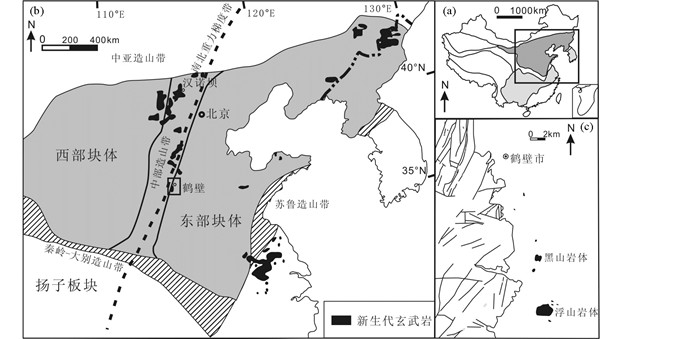
|
图 1 华北克拉通位置图(a)、华北克拉通构造简图(b, 据Yang et al., 2010修改) 和鹤壁新生代玄武岩和主要裂谷系分布图(c) Fig. 1 Location of the North China Craton (a), schematic geological map of the North China Craton (b, modified after Yang et al., 2010) and distribution of the Cenozoic basalts and major rifts in Hebi |
本文样品采集于鹤壁市以南~15km处的浮山岩体(FS01-FS05,10JH01-10JH04) 和黑山岩体(10JH05-10JH08)(图 1c),为该地区最大的两个岩体,浮山岩体约3km2,黑山岩体约0.5km2。岩体受NNE向断裂控制,整体为层状产出,覆盖在上第三系鹤壁组之上或侵入之中,被盖在第四系下更新统砾岩之下,喷发年龄为4.0~4.3Ma (全岩K-Ar年龄; 刘若新等, 1992),应为同期岩浆作用,岩体在深部相连。岩石类型较为单一,主要为橄榄玄武岩,次为玄武质火山碎屑岩。橄榄玄武岩深灰-黑色,致密坚硬,具块状构造和气孔-杏仁构造(图 2a)。斑状结构,斑晶包括橄榄石、辉石。橄榄石斑晶粒径平均为300μm,呈自形-半自形,短柱状或不规则颗粒状,可见两端尖锐的六边形晶形,未见解理但不规则裂纹发育,正高突起,糙面较明显,橄榄石斑晶大多伊丁石化(图 2b, e),说明玄武岩遭受了表生氧化作用,部分见溶蚀结构(图 2e),除此之外未发现其它后期改造特征;辉石斑晶主要为单斜辉石,自形-半自形,干涉色最高达Ⅱ级蓝绿(图 2c)。基质为针状斜长石微晶构成格架状,其间充填有细小的辉石和橄榄石、磁铁矿以及火山玻璃,构成间粒-间隐结构。
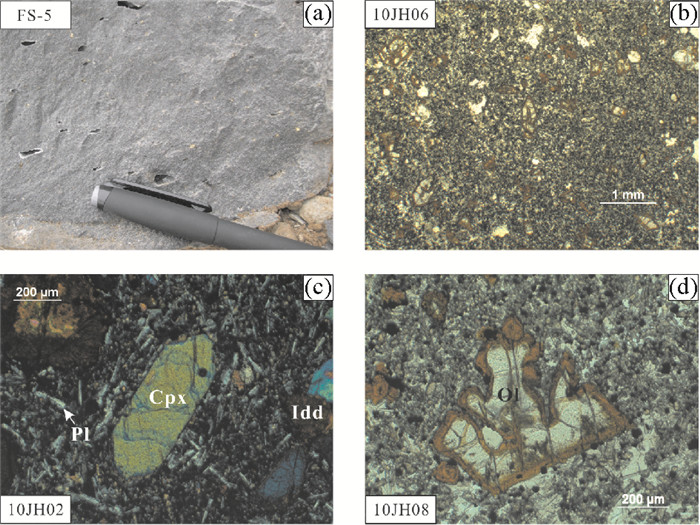
|
图 2 鹤壁玄武岩野外照片(a) 和显微照片(b-d) (b) 和(d) 为单偏光,(c) 为正交偏光 Fig. 2 Microphotographs of the Cenozoic basalts in Hebi |
对野外采集的样品进行岩相观察后,挑选出11件新鲜样品进行全岩地球化学和Sr-Nd-Hf同位素分析,所有分析测试都在中国科学院地质与地球物理研究所完成。全岩主量元素采用X荧光光谱(XRF) 玻璃熔片分析法,分析精度为1%(含量>10%) 和5%(含量 < 1.0%)。全岩微量元素分析在多接收等离子体质谱实验室完成,样品的制备采用混合酸溶样法。首先,准确称取岩石样品粉末50mg于Teflon有盖溶样弹中,加入1.5mL高纯HNO3,1.5mL高纯HF和0.01mL高纯HClO4。然后置于140℃的电热板上开盖并加热蒸干,再次加入1.5mL高纯HNO3,1.5mL高纯HF,加盖装入钢套。将拧紧钢套并置于195℃烘箱中加热48h。取出再次蒸干后加入3mL高纯HNO3并保持140℃蒸干,以去除残余的HF。再次加入3mL浓度为50%的HNO3,加盖放入钢套中,在150℃温度下加热24h,以保证样品提取完全。最后将样品倒入100mL的PET瓶中,加入1g铑内标并加水定容至100g。样品测试选用Agilent 7500a型四极杆电感耦合等离子体质谱仪(ICP-MS) 进行测定,分析精度依所测元素的浓度高低而变化于5%~10%之间。
全岩的Sr、Nd和Hf同位素分析在Thermo Fisher Scientific Neptune MC-ICP-MS上完成的,详细测试流程请参见文献(Yang et al., 2010b; Yang et al., 2011a, b)。准确称取200目样品粉末150mg于Teflon溶样弹中,依次加入2.5mL HF、0.2mL HNO3和HCLO4,加钢套后放入190℃烘箱烘烤一周。冷却后的样品置于电热板上蒸干,驱走HCLO4,然后加入6M HCL溶解样品并再次蒸干用以将氟化物全部转换为氯化物,最后用3M HCl提取溶解好的样品准备化学分离。Lu-Hf的化学分离采用Eichrom Ln-spec树脂(100~150μm, 2mL)。分别使用3M和4M HCL对上样后的树脂淋洗基体元素并获取含主量元素和轻、中稀土元素的溶液用于下一步分离。然后加注6M HCl淋滤残余的Lu和Yb,以保证提取Hf的纯度。基体元素Ti与Hf的分离通过4N HCl+0.5% H2O2实现。最后用2M HF淋洗Hf,用于MC-ICP-MS分析。该方法在(Münker et al., 2001) 的基础上改进而建立。Rb-Sr化学分离使用标准阳离子交换树脂,得到的Sr再经Sr特效树脂纯化后进行质谱分析(Balcaen et al., 2005)。用6M HCl淋洗得到轻、中稀土,加注到Eichrom Ln树脂(100~150μm, 2mL) 上,分别用0.25M HCl和0.4M HCL淋洗得到Sm和Nd。整个流程的空白含量为Sr < 100pg,Nd < 50pg,Hf < 50pg。Sr-Nd-Hf同位素的分馏分别采用86Sr/88Sr=0.1194, 146Nd/144Nd=0.7219和179Hf/177Hf=0.7325进行校正,采用指数法。测试过程中,Sr同位素标准样品NBS987的测定结果为0.710249±12(2SD, n=15),Nd同位素标准样品JNdi-1的测定结果为0.512115±12(2SD,n=15),Hf同位素标准样品Alfa Hf 14374的测定结果为0.282185±10(2SD, n=15)。
4 分析结果 4.1 主量元素特征鹤壁玄武岩全岩主量和微量元素分析结果见表 1。在TAS图上(图 3),样品分布于碱性玄武岩区域且为钠质(Na2O>K2O),经CIPW标准矿物计算得出岩石均含有霞石和橄榄石而无石英和紫苏辉石。因此,该区新生代玄武岩主要为碧玄岩和碱性橄榄玄武岩。相对于碱性橄榄玄武岩的SiO2(46.2%~47.8%),Na2O (3.1%~4.2%),CaO (8.0%~9.4%),P2O5(0.6%~0.7%),碧玄岩的SiO2(44.9%~45.1%) 更低而Na2O (5.2%~5.4%)、CaO (9.2%~9.3%)、P2O5(0.9%) 的含量更高。与冀北汉诺坝碱性玄武岩相比,该地区样品的MgO变化范围较小,除Fe2O3T和P2O5含量明显偏小外,其他氧化物的含量分布与汉诺坝岩石相似(图 4)。同时,该区样品内部SiO2、TiO2、Al2O3、CaO、Na2O、K2O和MgO之间并未显示出相关性。
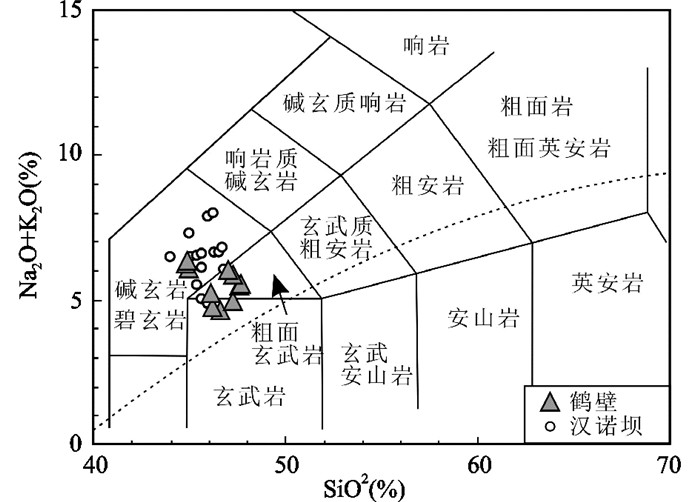
|
图 3 玄武岩Na2O+K2O-SiO2图(据Le Maitre, 2002) 虚线为碱性与亚碱性系列分界线,汉诺坝碱性玄武岩数据引自Zhi et al.(1990);Basu et al.(1991) Fig. 3 Plots of Na2O+K2O-SiO2 (after Le Maitre, 2002) |
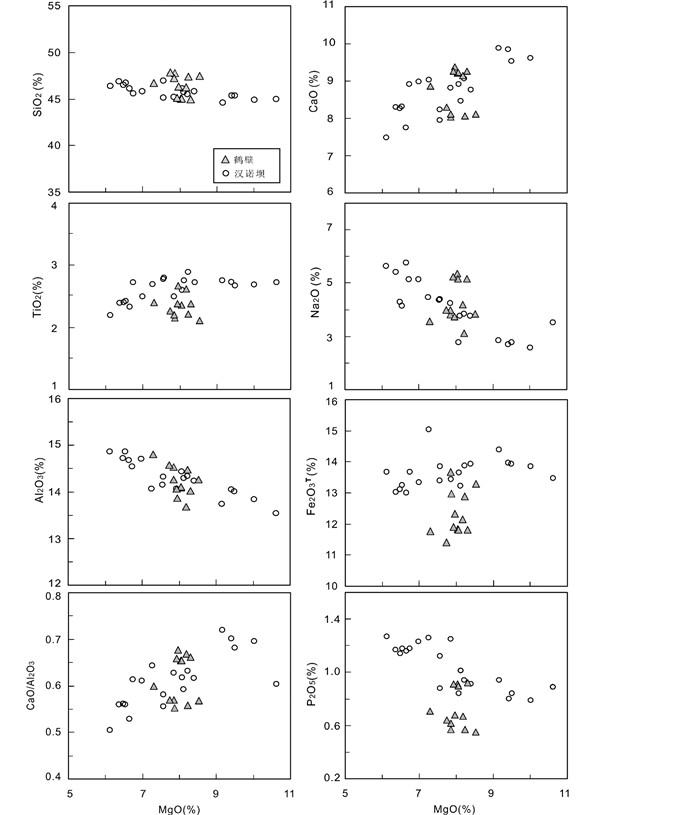
|
图 4 鹤壁玄武岩氧化物与MgO二元相关图 汉诺坝数据来源同图 3 Fig. 4 Various oxide plots against MgO for Cenozoic basalts in Hebi |
|
|
表 1 鹤壁玄武岩主量元素(wt%) 和微量元素含量(×10-6) Table 1 Major (wt%) and trace elements (×10-6) data of basalts from Hebi |
鹤壁新生代碱性玄武岩稀土总量变化范围为152×10-6~205×10-6,明显富集轻稀土元素。在球粒陨石标准化配分模式图上(图 5),呈现右倾曲线,轻、重稀土元素强烈分馏,(La/Yb)N=15.1~21.4,(Dy/Yb)N=2.1~2.4,无Eu和Ce的负异常。原始地幔标准化蛛网图中,大离子亲石元素(LILE;如Rb、Ba、Th、U、Sr) 和高场强元素(HFSE;如Zr、Hf、Ti) 富集,具有明显的Nb、Ta和Sr正异常、Hf弱负异常。不相容元素比值Nb/U=32.0~49.8,La/Nb=0.4~0.7、Ba/Nb=3.6~11。鹤壁玄武岩的微量元素特征和洋岛玄武岩(OIB) 的特征相似,暗示二者可能来源于相同的地幔源区。进一步分析可得出,样品中的碧玄岩相对于碱性橄榄玄武岩更为富集LILE和HFSE,其Nb/U更高而La/Nb、Ba/Nb更低(表 1),成分上与OIB更为相近。岩浆中的橄榄石是Ni、Cr的主要赋存矿物,其经历分离结晶作用后会使这些元素表现出和MgO正相关性,如汉诺坝碱性玄武岩;鹤壁碱性玄武岩并未表现出这种相关性,且具有较高的Ni、Cr含量(图 6)。
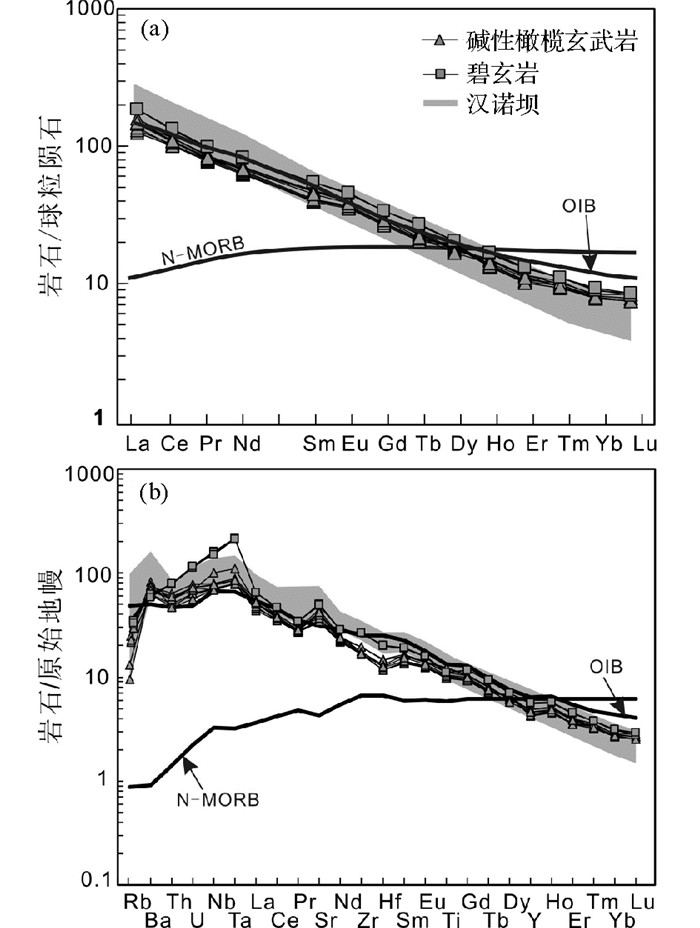
|
图 5 稀土元素球粒陨石标准化配分图(a) 和不相容元素原始地幔标准化图(b)(球粒陨石及原始地幔标准化数值据Sun and McDonough, 1989) Fig. 5 Chondrite-normalized REE patterns (a) and primitive mantle normalized trace element diagrams (b) (normalization values after Sun and McDonough, 1989) |
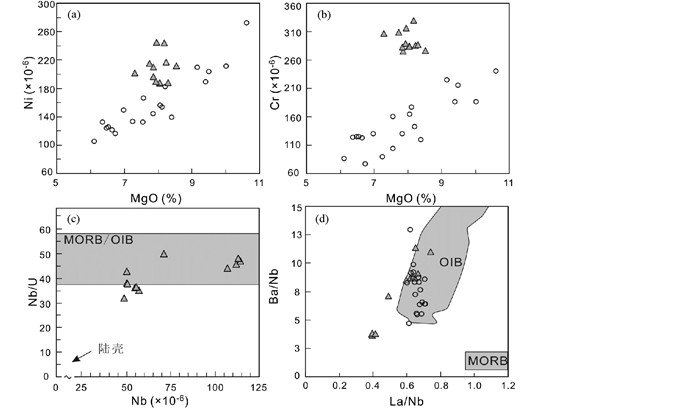
|
图 6 相容元素Ni (a)、Cr (b) 与MgO二元相关图及Nb/U-Nb (c)、La/Nb-Ba/Nb (d) 变化图 图(c, d) 中阴影范围据Hofmann et al.(1986),OIB和MORB区域据Sun and McDonough (1989) Fig. 6 Plots of Ni (a) and Cr (b) vs. MgO and diagrams of Nb/U vs. Nb (c), La/Nb vs. Ba/Nb (d) |
全岩Sr-Nd-Hf同位素分析结果见表 2。样品同位素比值的变化范围相对较小,87Sr/86Sri=0.7036~0.7044,εNd(t)=+0.4~+5.4、εHf(t)=+5.0~+9.7。岩石同位素二元相关图中(图 7),87Sr/86Sri与εNd(t) 负相关,位于OIB所在的亏损地幔象限内且靠近原始地幔值;εHf(t) 与εNd(t) 成正相关,同样位于OIB所在的区域内,并与地幔演化趋势线重合。其中,碧玄岩的Sr-Nd-Hf同位素比值要比碱性橄榄玄武岩更为亏损,这种差别可能是二者地幔源区性质的不同或者说碧玄岩所代表的岩浆成分较碱性橄榄玄武岩更为原始。总体来说,鹤壁碱性玄武岩与汉诺坝碱性玄武岩在同位素上有着相似的特征(Song et al., 1990;Zhi et al., 1990;Basu et al., 1991),都具有洋岛玄武岩(OIB) 类似的同位素组成。

|
图 7 玄武岩87Sr/86Sri-εNd(t) 相关图(a) 和εNd(t)-εHf(t) 相关图(b) 图(a) 中:MORB和OIB数据引自Zindler and Hart (1986),古老岩石圈地幔数据引自Zhang et al.(2002),太行山中生代镁铁质岩石数据引自Zhang et al.(2004);混合模型曲线参数:FS-26,FS-12为繁峙地幔橄榄岩,据Tang et al.(2006),软流圈数据引自Flower et al.(1998);图(b) 中:MORB和OIB及地幔趋势线数据引自Nowell et al.(1998),方城玄武岩数据引自Zhang et al.(2002),杨岳衡等(2006);鹤壁橄榄岩Sr-Nd数据引自Tang et al.(2012) Fig. 7 87Sr/86Sr vs. εNd(t) (a) and εHf(t) vs. εNd(t) (b) plots for basalts |
|
|
表 2 鹤壁玄武岩全岩Sr,Nd和Hf同位素组成 Table 2 Sr, Nd and Hf isotopic compositions of basalts from Hebi |
大陆玄武岩具有复杂的岩石类型和地球化学组成,这些特征可能是岩浆源区、熔融程度和地壳混染共同作用的结果(Farmer,2003)。因此,本文将根据鹤壁玄武岩的地球化学特征和Sr-Nd-Hf同位素组成,推测其岩浆源区和成岩过程,并结合区域地质演化,讨论其形成的可能地球动力学背景。
5.1 岩浆演化过程显微镜下观察,鹤壁玄武岩岩石样品除橄榄石斑晶发生伊丁石化外,未见其它矿物和基质发生后期蚀变,且鹤壁玄武岩的主量元素分析结果显示(表 1),烧失量平均值为1.0%,也进一步说明样品新鲜。
与大洋岩石圈不同,大陆具有巨厚的岩石圈地幔和地壳,幔源岩浆上升运移过程中,通常遭受大陆岩石圈物质的混染。然而,鹤壁玄武岩具有较高的MgO、Cr和Ni含量,较低的SiO2,并且在原始地幔标准化蛛网图上具有明显的正Nb、Ta异常,而大陆地壳的显著特征是具有明显的负Nb、Ta异常。其Nb/U值与MORB/OIB (47±7;Hofmann et al., 1986) 相同,明显高于陆壳的Nb/U比值(图 6c)。其它不相容元素含量如Sr (709×10-6~1056×10-6)、Ba (405×10-6~569×10-6),显著高于下部陆壳的平均值(Sr=320×10-6,Ba=456×10-6;Rudnick and Gao, 2003)。再者,鹤壁玄武岩87Sr/86Sri比值与MgO也并未出现由于陆壳混染所引起的正相关关系。因此,鹤壁新生代玄武岩在形成过程中未遭受明显的地壳物质混染。
鹤壁新生代玄武岩中含有橄榄石和辉石的斑晶,表明岩浆在演化过程中可能经历了橄榄石和辉石的分离结晶作用。微量元素相关图表明鹤壁玄武岩与汉诺坝碱性玄武岩类似,强不相容元素之间呈现良好的线性关系(图 8),也进一步说明辉石的分离结晶作用。但该区样品的MgO含量总体大于8%,Ni、Cr含量也位于地幔橄榄岩相平衡的范围内(Wilkinson and Maitre, 1987),同时Ni、Cr与MgO之间并未见任何相关性,显著区别于经历分离结晶作用的汉诺坝碱性玄武岩(图 6a, b),表明橄榄石和辉石的分离结晶作用程度较小。此外,鹤壁玄武岩在球粒陨石标准化稀土元素配分图上不具有明显的负Eu异常(图 5),说明斜长石未发生结晶分离作用。
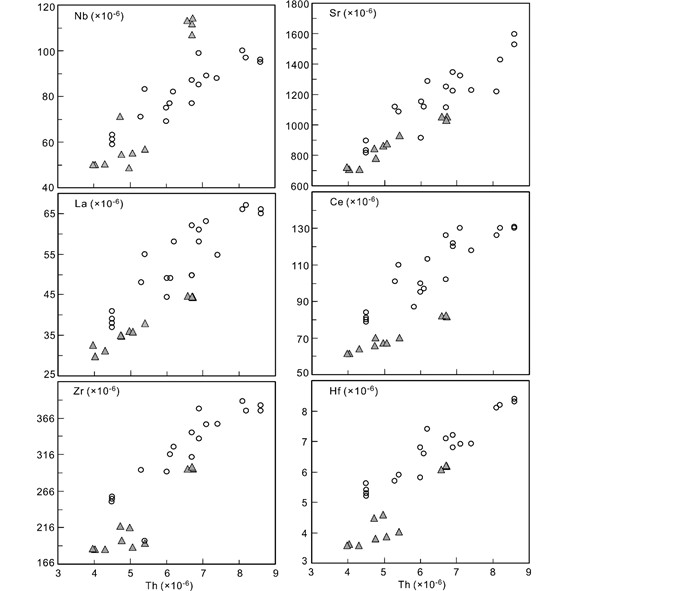
|
图 8 不相容元素与Th的关系图 数据来源同图 3 Fig. 8 Contents of incompatible elements vs. Th |
岩相学和全岩地球化学研究表明,鹤壁新生代碱性玄武岩在形成过程中经历了较弱的橄榄石和辉石分离结晶作用和地壳混染作用,岩石结晶后期蚀变作用不明显。因此,这些玄武岩样品(尤其是高MgO样品) 的地球化学特征接近接近原始岩浆的成分,并可以反应出其地幔源区特征和部分熔融条件。
5.2 地幔源区鹤壁新生代玄武岩具有贫硅、富镁的特征,实验岩石学研究表明,基性和超基性岩浆是上地幔镁铁质岩石部分熔融的产物(Hirose and Kushiro, 1993; Walter, 2003)。相对饱满的地幔岩石熔融产生的熔体具有较高的Ti和Fe含量(Falloon et al., 1988),鹤壁碱性玄武岩的TiO2=2.1%~2.7%,Fe2O3T=11.4%~13.7%,说明它们来源于一个相对饱满的的地幔源区,其源区在鹤壁碱性玄武岩形成之前,未经历大程度熔体的抽离。鹤壁新生代碱性玄武岩87Sr/86Sri比值,εNd(t) 和εHf(t) 值分别为0.7036~0.7044,+0.4~+5.4和+5.0~+9.7,呈现不均一的亏损同位素组成特征。在Sr-Nd和Nd-Hf同位素相关图上(图 7),分布在OIB范围之内,并呈现明显的线性关系,类似于中国东部其它地区新生代碱性玄武岩(Zhou and Armstrong, 1982; Zhang et al., 2009; Wang et al., 2011),表明至少两个端元组分参与了鹤壁新生代碱性玄武岩的成岩作用,即亏损地幔(DM) 和富集地幔(EM)。其中亏损地幔为软流圈或者新生岩石圈地幔,而富集地幔则可能是Ⅰ型富集地幔(EMⅠ,Zhou and Armstrong, 1982; Zhi et al., 1990) 或者Ⅱ型富集地幔(EMⅡ,Zou et al., 2000)。但根据鹤壁玄武岩中地幔包体研究表明,虽然华北东部岩石圈地幔在古生代以来发生地幔性质的强烈改变,200km左右冷的、密度低、同位素富集的古老岩石圈地幔被70~100km热的、密度大的、同位素亏损的新生岩石圈地幔所代替(Fan and Menzies, 1992; Griffin et al., 1992, 1998; Menzies et al., 1993),但在鹤壁地区之下岩石圈地幔仍以残存古老的岩石圈地幔为主(Zheng et al., 2001, 2007; Tang et al., 2006, 2012)。最近的研究发现,鹤壁古老地幔包体的Sr-Nd同位素变化较大,且存在亏损特征的样品,可能是后期熔体改造作用的结果(Tang et al., 2011; Sun et al., 2012),其代表的地幔所熔出的玄武岩浆同样可以具有类似鹤壁碱性玄武岩的亏损性质。但是这些样品富集LILE,亏损HFSE,与鹤壁碱性玄武岩明显不同,故这种岩石圈地幔不可能是其地幔源区。因此,鹤壁新生代玄武岩中亏损地幔组分特征应来源于软流圈地幔。
富集地幔端元组分可能为上覆的古老岩石圈地幔,而前人研究表明只有饱满的地幔岩石才能熔出玄武质组分(Kelemen et al., 1998; Griffin et al., 1999)。华北克拉通下古老岩石圈地幔经历了大程度熔体的抽离,很难生成大规模的镁铁质岩浆。再者,难熔的古老岩石圈地幔经过地幔交代再富集之后发生部分熔融可以形成镁铁质岩浆(Kelemen et al., 1998; Griffin et al., 1999),但形成的多为金伯利岩、煌斑岩等岩石。因此,古老克拉通岩石圈地幔不会成为大陆玄武岩的主要源区,鹤壁新生代玄武岩的岩浆源区不可能来源于古老岩石圈地幔,而是软流圈地幔发生部分熔融的产物。
鹤壁新生代玄武岩的不均一同位素组成表明,来自软流圈地幔的岩浆在上升过程中与岩石圈地幔橄榄岩发生强烈的相互作用。而根据该岩体中产出的地幔包体的研究表明,鹤壁地区岩石圈地幔厚度约80km左右(尖晶石相,Zheng et al., 2001)),并且经历了富集、交代作用,具有类似于EMⅠ的富集Sr-Nd-Hf同位素组成,可能是经俯冲板片来源的富含挥发分的熔/流体交代后的古老岩石圈地幔(Zhang et al., 2004;Wang et al., 2006; 汤艳杰等, 2006;Tang et al., 2012)。全岩地球化学和Sr-Nd-Hf同位素研究表明,鹤壁碱性玄武岩浆是由软流圈熔融而成的熔体与EMⅠ型富集的古老岩石圈地幔橄榄岩相互作用的产物。根据Sr-Nd同位素的二端元混合模拟计算(图 7a) 得出富集端元组分约占4%~10%,如此小比例的混合对玄武岩的主量元素和微量元素改变不明显,这与该区样品的主微量元素的特征相一致。
综上所述,鹤壁新生代玄武岩是由软流圈地幔部分熔融而成,并有少量EMⅠ型的古老岩石圈地幔物质加入,这与太行山其他地区新生代玄武岩的成因具有一致性(Tang et al., 2006)。
5.3 熔融深度与程度玄武岩的硅饱和程度与熔融深度有关(DePaolo and Daley, 2000),硅不饱和的碱性岩浆产生的压力要高于硅饱和的拉斑质玄武岩浆。Nohda et al.(1991)提出华北的拉斑玄武岩的源区压力为15~20kbar (50~60km),而碱性玄武岩的源区压力为25~30kbar (>80km)。鹤壁新生代玄武岩全部为碱性玄武岩,且具有软流圈地幔的亏损同位素特征,可知其地幔源区应不小于80km。鹤壁新生代玄武岩明显富集轻稀土元素,(La/Yb)N=15.1~21.4、(Dy/Yb)N=2.1~2.4。实验岩石学研究表明,轻重稀土元素强烈分馏的原因可能是源区存在石榴石。对于石榴石来说,Yb是的相容元素而La、Sm是不相容元素,石榴石相橄榄岩部分熔融程度越低,对应的La/Yb和Sm/Yb分异作用越明显;在尖晶石相橄榄岩部分熔融作用中,La/Yb变化较小、Sm/Yb基本不变化,因此La/Yb-Sm/Yb图解常用于区分来自石榴石相橄榄岩和尖晶石相橄榄岩源区的玄武岩(Xu et al., 2005)。鹤壁碱性玄武岩的La/Yb-Sm/Yb分布图中可以看出(图 9a),该地区玄武岩投在石榴石二辉橄榄岩熔融模拟曲线上,且熔融程度较小约1%~3%。另外,该地区新生代玄武岩包体以尖晶石二辉橄榄岩为主,仅发现极少量的具尖晶石/石榴石相转变特征的五相共存(Gt+Sp+Cpx+Opx+Ol) 二辉橄榄岩,并未发现典型四相特征的石榴石橄榄岩, 据尖晶石/石榴石二辉橄榄岩计算的形成压力为1970Mpa,约相当于65km深度,(樊祺诚和刘若新,1994;樊祺诚和隋建立,2009)。这些证据说明岩浆源区应主要为>65km的石榴石相软流圈地幔。不相容元素Zr/Y比值受部分熔融程度的影响但不受分离结晶作用的影响(Nicholson and Latin, 1992),可以反映熔融过程,熔体中的Zr相对于Y更不相容,熔融程度越低,Zr/Y比越高;实验证明地幔熔体产生过程中,FeO随熔融深度的增加或源区压力的增大而加大(Nicholson and Latin, 1992; Langmuir et al., 1993)。因而,熔融程度越低的熔体成分其Zr/Y越低而FeO含量越高。该地区岩石Zr/Y值未发生变化(图 9b),说明熔融程度变化不大,与上述模拟计算结果一致。
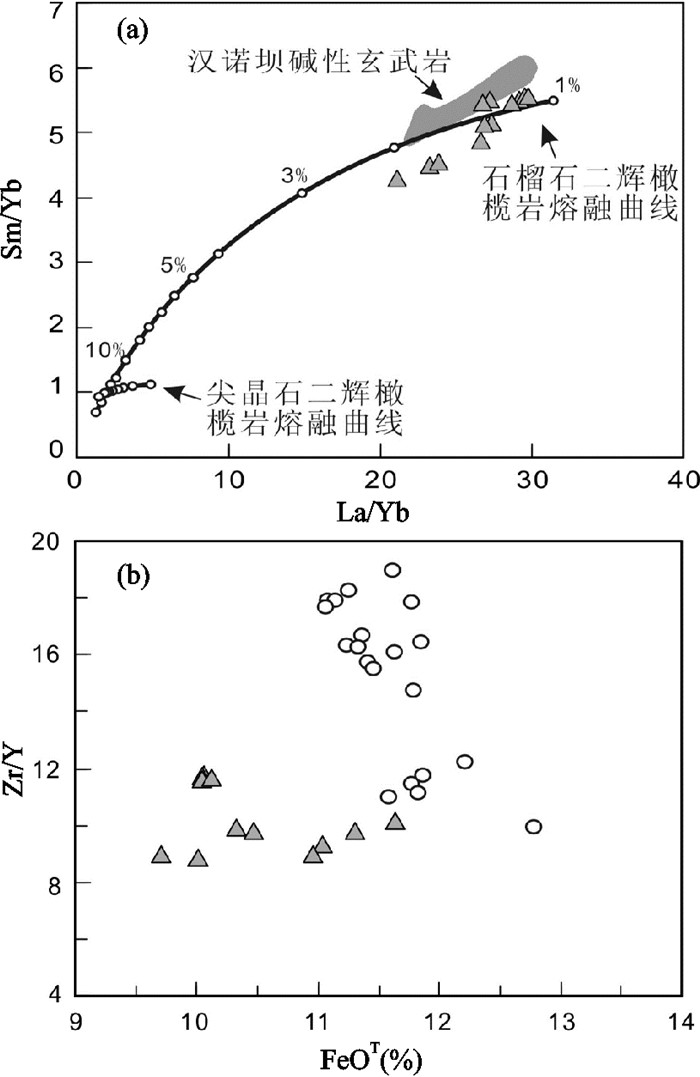
|
图 9 La/Yb-Sm/Yb变化图(a) 和FeOT-Zr/Y变化图(b) 图(a) 中曲线为地幔岩石批次部分熔融曲线,曲线旁数字代表熔融比例;源岩矿物组分和矿物熔融比例数据引自Johnson et al.(1990),元素分配系数据McKenzie and O’Nions.(1991);图(b) 中FeOT(%) 由Fe2O3T(%) 等摩尔Fe含量计算得出,数据来源同图 3 Fig. 9 La/Yb vs. Sm/Yb (a) and FeOT vs. Zr/Y (b) for Hebi basalts |
太行山地区自中生代以来发育有两期的幔源岩浆活动,第一期岩浆活动主要集中于晚中生代,岩浆成分有着EMⅠ型富集的Sr-Nd同位素特征,由古老的岩石圈地幔熔融产生;第二期岩浆活动发生于古近纪晚期到新近纪,岩浆成分均显现出亏损的同位素特征,起源于软流圈地幔(Zhang et al., 2004;Tang et al., 2006;Wang et al., 2006;汤艳杰等, 2006),两期岩浆活动之间则缺少基性岩浆作用。这些岩浆演化特征可以用拉张环境下的岩石圈演化来解释。实验岩石学证明大陆在拉张过程中首先会发生富水岩石圈地幔的熔融抽取作用,这种抽取使得岩石圈地幔变“干”且短时间内无法补回,因而不再发生熔融作用,同时拉伸作用使得岩石圈逐渐减薄,当厚度小于65~80km时,软流圈地幔便开始发生熔融, 即基性岩浆的地幔源区由岩石圈地幔转变为软流圈地幔,且中间会出现一岩浆间隔期(Gallagher and Hawkesworth, 1992; 徐义刚, 2006)。据此,我们认为鹤壁所处的太行山地区的古老岩石圈地幔在中生代以前受元古代俯冲作用而富水,随后因拉张作用发生减薄熔融生成基性岩浆,并使得原本富水的岩石圈地幔失水,变干的岩石圈地幔在拉张作用下继续减薄但不会发生熔融作用,到始新世时,软流圈地幔开始发生小程度熔融作用,进而造成碱性玄武岩的喷发。
太行山地区的新生代玄武岩浆作用的动力学机制一直未有定论。一种观点认为与印度-欧亚板块碰撞有关,印度板块的北向俯冲推挤作用造成鄂尔多斯块体的逆时针旋转,外围发育上新世-第四纪裂谷系,该伸展作用促使太行山地区岩石圈拉伸减薄,软流圈物质上涌产生玄武岩浆作用(Ren et al., 2002;Zhang et al., 2003;Tang et al., 2006)。另一种观点认为与太平洋的西向俯冲有关,全球地震层析揭示俯冲的太平洋板片已停滞在中国东部岩石圈下的转换带内(Fukao et al., 1992;Zhao, 2004),其西端水平延伸至太行山重力梯度带之下(Pei et al., 2004),俯冲地幔楔内的地幔环流促使西部的地幔物质向东部补充,由于东西部岩石圈厚度差异,东移的地幔流减压熔融产生岩浆作用(牛耀龄, 2005),同时Zhao et al. (2011)也据地球物理资料得出太行山地区岩石圈下部的上涌地漫流与印度-欧亚碰撞无关。大兴安岭-太行山重力梯度带是这两种构造域的边界(Xu, 2007),究竟该地区的新生代岩浆作用受控于单一机制还是两种机制的共同作用,还需要进一步的研究来限制。
7 结论鹤壁新生代玄武岩为碱性玄武岩,包括碱性橄榄玄武岩和碧玄岩两类。岩石的岩浆演化过程中未发生显著的地表改造、地壳混染和分离结晶作用,全岩成分可用于研究其源区特征和熔融性质。全岩地球化学和Sr-Nd-Hf同位素组成指示其由石榴石相的软流圈地幔经小程度的熔融而成,且熔体在上升过程中与EMⅠ型的古老岩石圈地幔橄榄岩发生了相互作用。
致谢 衷心感谢樊祺诚研究员和匿名评审专家对本文初稿提出的建设性意见。测试工作得到了中国科学院地质与地球物理研究所多接受电感耦合等离子体质谱实验室老师的指导与帮助,在此一并致谢。| [] | Balcaen L, Schrijver ID, Moens L, Vanhaecke F. 2005. Determination of the 87Sr/86Sr isotope ratio in USGS silicate reference materials by multi-collector ICP-mass spectrometry. International Journal of Mass Spectrometry, 242(2-3): 251–255. DOI:10.1016/j.ijms.2004.10.025 |
| [] | Basu AR, Wang JW, Huang WK, Xie GH, Tatsumoto M. 1991. Major element, REE, and Pb, Nd, and Sr isotopic geochemistry of Cenozoic volcanic rocks of eastern China: Implications for their origin from suboceanic-type mantle reservoirs. Earth Planetary Science Letters, 105(1-3): 149–169. DOI:10.1016/0012-821X(91)90127-4 |
| [] | Blichert-Toft J, Albarède F. 1997. The Lu-Hf isotope geochemistry of chondrites and the evolution of the mantle-crust system. Earth and Planetary Science Letters, 148(1-2): 243–258. DOI:10.1016/S0012-821X(97)00040-X |
| [] | Chung SL. 1999. Trace element and isotope characteristics of Cenozoic basalts around the Tanlu fault with implications for the eastern plate boundary between North and South China. The Journal of Geology, 107(3): 301–312. DOI:10.1086/314348 |
| [] | DePaolo DJ, Daley EE. 2000. Neodymium isotopes in basalts of the southwest basin and range and lithospheric thinning during continental extension. Chemical Geology, 169(1-2): 157–185. DOI:10.1016/S0009-2541(00)00261-8 |
| [] | Falloon TJ, Green DH, Hatton CJ, Harris KL. 1988. Anhydrous partial melting of a fertile and depleted peridotite from 2 to 30 kb and application to basalt petrogenesis. Journal of Petrology, 29(6): 1257–1282. DOI:10.1093/petrology/29.6.1257 |
| [] | Fan QC, Hooper PR. 1991. The Cenozoic basaltic rocks of eastern China: Petrology and chemical composition. Journal of Petrology, 32(4): 765–810. DOI:10.1093/petrology/32.4.765 |
| [] | Fan QC and Liu RX. 1994. Spinel-garnet lherzolite in Late Tertiary limburgitic pipe from Hebi, Henan Province and its genesis. In: Ouyang ZY (ed.). New Progress in Mineralogy, Metrology and Geochemistry Study in China. Lanzhou: Lanzhou University Press, 141-142 (in Chinese) |
| [] | Fan QC, Sui JL. 2009. Phase transition of upper mantle rock in eastern China and its significance. Earth Science, 34(3): 387–391. |
| [] | Fan WM, Menzies MA. 1992. Destruction of aged lower lithosphere and accretion of asthenosphere mantle beneath eastern China. Geotectonica Metallogenia, 16: 171–181. |
| [] | Fan WM, Zhang HF, Baker J, Jarvis KE, Mason PRD, Menzies MA. 2000. On and off the North China craton: Where is the Archean Keel?. Journal of Petrology, 41(7): 933–950. DOI:10.1093/petrology/41.7.933 |
| [] | Farmer GL. 2003. Continental basaltic rocks. In: Holland HD (ed.). Treatise on Geochemistry, Volume 3. New York: Elsevier, 85-121 |
| [] | Flower M, Tamaki K and Hoang N. 1998. Mantle extrusion: A model for dispersed volcanism and Dupal-like asthenosphere in East Asia and the Western Pacific. In: Flower MFJ, Chung SL, Lo CH and Lee TY (eds.). Mantle Dynamics and Plate Ineractions in East Asia. Geodynamics Series, Vol. 27. AGU, Washington, 67-88 |
| [] | Fukao Y, Obayashi M, Inous H, Nenbai M. 1992. Subducting slab stagnant in the mantle transition zone. Journal of Geophysical Research, 97(B4): 4809–4822. DOI:10.1029/91JB02749 |
| [] | Gallagher K, Hawkesworth C. 1992. Dehydration melting and the generation of continental flood basalts. Nature, 358(6381): 57–59. DOI:10.1038/358057a0 |
| [] | Gilder SA, Keller GR, Luo M, Goodell PC. 1991. Eastern Asia and the western Pacific timing and spatial distribution of rifting in China. Tectonophysics, 197(2-4): 225–243. DOI:10.1016/0040-1951(91)90043-R |
| [] | Griffin WL, O'Reilly SY and Ryan CG. 1992. Composition and thermal structure of the lithosphere beneath South Africa, Siberia and China: Proton microprobe studies. In: Abstract of International Symposium on Cenozoic Volcanic Rocks and Deep-seated Xenoliths of China and Its Environs. Beijing, 1-20 |
| [] | Griffin WL, Zhang AD, O'reilly SY and Ryan CG. 1998. Phanerozoic evolution of the lithosphere beneath the Sino-Korean Craton. In: Flower MFJ, Chung SL, Lo CH and Lee TY (eds.). Mantle Dynamics and Plate Interactions in East Asia. Geodynamics Series, Vol. 27. AGU, Washington, 107-126 |
| [] | Griffin WL, O'Reilly SY and Ryan C. 1999. The composition and origin of sub-continental lithospheric mantle. In: Fei Y, Bertka CM and Mysen BO (eds.). Mantle Petrology: Field Observations and High-Pressure Experimentation. A Tribute to France R. (Joe) Boyd. Geochemical Society Special Publications, 6: 13-46 |
| [] | Griffin WL, Pearson NJ, Belousova E, Jackson SE, Van Achterbergh E, O'Reilly SY, Shee SR. 2000. The Hf isotope composition of cratonic mantle: LAM-MC-ICPMS analysis of zircon megacrysts in kimberlites. Geochimica et Cosmochimica Acta, 64(1): 133–147. DOI:10.1016/S0016-7037(99)00343-9 |
| [] | Hirose K, Kushiro I. 1993. Partial melting of dry peridotites at high pressures: Determination of compositions of melts segregated from peridotite using aggregates of diamond. Earth and Planetary Science Letters, 114(4): 477–489. DOI:10.1016/0012-821X(93)90077-M |
| [] | Ho KS, Liu Y, Chen JC, You CF, Yang HJ. 2011. Geochemical characteristics of Cenozoic Jining basalts of the western North China Craton: Evidence for the role of the lower crust, lithosphere, and asthenosphere in petrogenesis. Terrestrial, Atomspheric and Ocean Sciences, 22(1): 15–40. DOI:10.3319/TAO.2010.06.28.01(TT) |
| [] | Hofmann AW, Jochum KP, Seufert M, White WM. 1986. Nb and Pb in oceanic basalts: New constraints on mantle evolution. Earth and Planetary Science Letters, 79(1-2): 33–45. DOI:10.1016/0012-821X(86)90038-5 |
| [] | Hofmann AW. 1997. Mantle geochemistry: The message from oceanic volcanism. Nature, 385(6613): 219–229. DOI:10.1038/385219a0 |
| [] | Jahn BM, Auvray B, Cornichet J, Bai YL, Shen QH, Liu DY. 1987. 3.5Ga old amphibolites from eastern Hebei Province, China: Field occurrence, petrography, Sm-Nd isochron age and REE geochemistry. Precambrian Research, 34(3-4): 311–346. DOI:10.1016/0301-9268(87)90006-4 |
| [] | Johnson KTM, Dick HJB, Shimizu N. 1990. Melting in the oceanic upper mantle: An ion microprobe study of diopsides in abyssal peridotites. Journal of Geophysical Research, 95(B3): 2661–2678. DOI:10.1029/JB095iB03p02661 |
| [] | Kelemen PB, Hart SR, Bernstein S. 1998. Silica enrichment in the continental upper mantle via melt/rock reaction. Earth and Planetary Science Letters, 164(1-2): 387–406. DOI:10.1016/S0012-821X(98)00233-7 |
| [] | Langmuir CH, Klein EM, Plank T. 1993. Petrological systematics of mid-ocean ridge basalts: Constraints on melt generation beneath ocean ridges. Geophysical Monograph-American Geophysical Union, 71: 183–183. |
| [] | Le Maitre RW, Streckeisen A, Zanettin B, Le Bas MJ, Bonin B, Bateman P, Bellieni G, Dubek A, Keller J, Lameyre J, Sabine PA, Schimid R, Sorensen H, Woollet AR. 2002. Igneous Rocks: A Classification of Igneous Rocks and Glossary of Terms. 2nd Edition. Cambridge. UK: Cambridge University Press: 1-236. |
| [] | Liu CQ, Masuda A, Xie GH. 1994. Major-and trace-element compositions of Cenozoic basalts in eastern China: Petrogenesis and mantle source. Chemical Geology, 114(1-2): 19–42. DOI:10.1016/0009-2541(94)90039-6 |
| [] | Liu DY, Nutman AP, Compston W, Wu JS, Shen QH. 1992. Remnants of≥3800Ma crust in the Chinese part of the Sino-Korean craton. Geology, 20(4): 339–342. DOI:10.1130/0091-7613(1992)020<0339:ROMCIT>2.3.CO;2 |
| [] | Liu JG, Rudnick RL, Walker RJ, Gao S, Wu FY, Piccoli PM, Yuan HL, Xu WL, Xu YG. 2011. Mapping lithospheric boundaries using Os isotopes of mantle xenoliths: An example from the North China Craton. Geochimica et Cosmochimica Acta, 75(13): 3881–3902. DOI:10.1016/j.gca.2011.04.018 |
| [] | Liu RX, Sun JZ, Chen WJ. 1983. Cenozoic basalts in North China: Their distribution, geochemical characteristics and tectonic implications. Chinese Journal of Geochemistry, 2(1): 17–33. |
| [] | Liu RX, Chen WJ, Sun JZ and Li DM. 1992. K-Ar chronology and tectonic settings of Cenozoic volcanic rocks in China. In: Liu RX (ed.). Geochronology and Geochemistry of Cenozoic Volcanic Rocks in China. Beijing: Seismological Press, 1-43 (in Chinese) |
| [] | Mckenzie DP, O'Nions RK. 1991. Partial melt distributions from inversion of rare earth element concentrations. Journal of Petrology, 32(5): 1021–1091. DOI:10.1093/petrology/32.5.1021 |
| [] | Menzies M, Fan WM and Zhang M. 1993. Paleozoic and cenozoic lithosprobes and loss of >120km of Archean lithosphere, Sino-Korean craton, China. Magmatic Processes and Plate Tectonics, 76. Geological Society, London, Special Publications, 71-81 |
| [] | Münker C, Weyer S, Scherer E, Mezger K. 2001. Separation of high field strength elements (Nb, Ta, Zr, Hf) and Lu from rock samples for MC-ICPMS measurements. Geochemistry Geophysics Geosystems, 2(12): 1064–1082. |
| [] | Nicholson H, Latin D. 1992. Olivine tholeiites from Krafla, Iceland: Evidence for variations in melt fraction within a plume. Journal of Petrology, 33(5): 1105–1124. DOI:10.1093/petrology/33.5.1105 |
| [] | Niu YL. 2005. Generation and evolution of basaltic magmas: Some basic concepts and a new view on the origin of Mesozoic-Cenozoic basaltic volcanism in eastern China. Geological Journal of China Universities, 11(1): 9–46. |
| [] | Nohda S, Chen H, Tatsumi Y. 1991. Geochemical stratification in the upper mantle beneath NE China. Geophysical Research Letters, 18(1): 97–100. DOI:10.1029/90GL02716 |
| [] | Nowell GM, Kempton PD, Noble SR, Fitton JG, Saunders AD, Mahoney JJ, Taylor RN. 1998. High precision Hf isotope measurements of MORB and OIB by thermal ionisation mass spectrometry: Insights into the depleted mantle. Chemical Geology, 149(3-4): 211–233. DOI:10.1016/S0009-2541(98)00036-9 |
| [] | Pei S, Chen YJ and Zhao DP. 2004. Tromographic structure of east Asia: Data and results. AGU Fall Meeting, San Francisco |
| [] | Ren JY, Tamaki K, Li ST, Zhang JX. 2002. Late Mesozoic and Cenozoic rifting and its dynamic setting in Eastern China and adjacent areas. Tectonophysics, 344(3-4): 175–205. DOI:10.1016/S0040-1951(01)00271-2 |
| [] | Rudnick RL and Gao S. 2003. Composition of the continental crust. In: Holland HD (ed.). Treatise on Geochemistry, Volume 3. New York: Elsevier, 1-64 |
| [] | Söderlund U, Patchett PJ, Vervoort JD, Isachsen CE. 2004. The 176Lu decay constant determined by Lu-Hf and U-Pb isotope systematics of Precambrian mafic intrusions. Earth and Planetary Science Letters, 219(3-4): 311–324. DOI:10.1016/S0012-821X(04)00012-3 |
| [] | Song Y, Frey FA, Zhi XC. 1990. Isotopic characteristics of Hannuoba basalts, eastern China: Implications for their petrogenesis and the composition of subcontinental mantle. Chemical Geology, 88(1-2): 35–52. DOI:10.1016/0009-2541(90)90102-D |
| [] | Sun J, Liu CZ, Wu FY, Yang YH, Chu ZY. 2012. Metasomatic origin of clinopyroxene in Archean mantle xenoliths from Hebi, North China Craton: Trace-element and Sr-isotope constraints. Chemical Geology, 328: 123–136. DOI:10.1016/j.chemgeo.2012.03.014 |
| [] | Sun SS and McDonough WF. 1989. Chemical and isotopic systematics of oceanic basalts: Implications for mantle composition and processes. In: Saunders AD and Norry MJ (eds.). Magmatism in the Ocean Basins. Geological Society, London, Special Publications, 42(1): 313-345 |
| [] | Tang YJ, Zhang HF, Ying JF. 2006. Asthenosphere-lithospheric mantle interaction in an extensional regime: Implication from the geochemistry of Cenozoic basalts from Taihang Mountains, North China Craton. Chemical Geology, 233(3-4): 309–327. DOI:10.1016/j.chemgeo.2006.03.013 |
| [] | Tang YJ, Zhang HF, Ying JF, Zhang J. 2006. Source characteristics and temporal-spatial evolution of Mesozoic and Cenozoic basaltic magmatism in the Taihang Mountains. Acta Petrologica Sinica, 22(6): 1657–1664. |
| [] | Tang YJ, Zhang HF, Nakamura E, Ying JF. 2011. Multistage melt/fluid-peridotite interactions in the refertilized lithospheric mantle beneath the North China Craton: Constraints from the Li-Sr-Nd isotopic disequilibrium between minerals of peridotite xenoliths. Contributions to Mineralogy and Petrology, 161(6): 845–861. DOI:10.1007/s00410-010-0568-1 |
| [] | Tang YJ, Zhang HF, Ying JF, Su BX, Chu ZY, Xiao Y, Zhao XM. 2012. Highly heterogeneous lithospheric mantle beneath the Central Zone of the North China Craton evolved from Archean mantle through diverse melt refertilization. Gondwana Research, 23(1): 130–140. |
| [] | Walter MJ. 2003. Melt extraction and compositional variability in mantle lithosphere. In: Holland HD (ed.). Treatise on Geochemistry, Volume 2. New York: Elsevier, 363-394 |
| [] | Wang Y, Zhao ZF, Zheng YF, Zhang JJ. 2011. Geochemical constraints on the nature of mantle source for Cenozoic continental basalts in east-central China. Lithos, 125(3-4): 940–955. DOI:10.1016/j.lithos.2011.05.007 |
| [] | Wang YJ, Fan WM, Zhang HF, Peng TP. 2006. Early Cretaceous gabbroic rocks from the Taihang Mountains: Implications for a paleosubduction-related lithospheric mantle beneath the central North China Craton. Lithos, 86(3-4): 281–302. DOI:10.1016/j.lithos.2005.07.001 |
| [] | Wilkinson JFG, Maitre RWL. 1987. Upper mantle amphiboles and micas and TiO2, K2O, and P2O5 abundances and 100Mg/(Mg+ Fe2+) ratios of common basalts and andesites: Implications for modal mantle metasomatism and undepleted mantle compositions. Journal of Petrology, 28(1): 37–73. DOI:10.1093/petrology/28.1.37 |
| [] | Xu YG, Ma JL, Frey FA, Feigenson MD, Liu JF. 2005. Role of lithosphere-asthenosphere interaction in the genesis of Quaternary alkali and tholeiitic basalts from Datong, western North China Craton. Chemical Geology, 224(4): 247–271. DOI:10.1016/j.chemgeo.2005.08.004 |
| [] | Xu YG. 2006. Using basalt geochemistry to constrain Mesozoic-Cenozoic evolution of the lithosphere beneath North China Craton. Earth Science Frontiers, 13(2): 93–104. |
| [] | Xu YG. 2007. Diachronous lithospheric thinning of the North China Craton and formation of the Daxin'anling-Taihangshan gravity lineament. Lithos, 96(1-2): 281–298. DOI:10.1016/j.lithos.2006.09.013 |
| [] | Yang JH, Wu FY, Wilde SA, Belousova E, Griffin WL. 2008. Mesozoic decratonization of the North China block. Geology, 36(6): 467–470. DOI:10.1130/G24518A.1 |
| [] | Yang JH, O'Reilly S, Walker RJ, Griffin W, Wu FY, Zhang M, Person N. 2010a. Diachronous decratonization of the Sino-Korean craton: Geochemistry of mantle xenoliths from North Korea. Geology, 38(9): 799–802. DOI:10.1130/G30944.1 |
| [] | Yang YH, Zhang HF, Xie LW, Liu Y, Qi CS, Tu XL. 2006. Petrogenesis of typical Mesozoic and Cenozoic volcanic rocks from the North China Craton: New evidence from Hf isotopic studies. Acta Petrologica Sinica, 22(6): 1665–1671. |
| [] | Yang YH, Zhang HF, Chu ZY, Xie LW, Wu FY. 2010b. Combined chemical separation of Lu, Hf, Rb, Sr, Sm and Nd from a single rock digest and precise and accurate isotope determinations of Lu-Hf, Rb-Sr and Sm-Nd isotope systems using Multi-Collector ICP-MS and TIMS. International Journal of Mass Spectrometry, 290(2-3): 120–126. DOI:10.1016/j.ijms.2009.12.011 |
| [] | Yang YH, Chu ZY, Wu FY, Xie LW, Yang JH. 2011a. Precise and accurate determination of Sm, Nd concentrations and Nd isotopic compositions in geological samples by MC-ICP-MS. Journal of Analytical Atomic Spectrometry, 26(6): 1237–1244. DOI:10.1039/c1ja00001b |
| [] | Yang YH, Wu FY, Xie LW, Yang JH, Zhang YB. 2011b. High-precision direct determination of the 87Sr/86Sr isotope ratio of bottled Sr-rich natural mineral drinking water using multiple collector inductively coupled plasma mass spectrometry. Spectrochimica Acta Part B: Atomic Spectroscopy, 66(8): 656–660. DOI:10.1016/j.sab.2011.07.004 |
| [] | Yarmolyuk VV, Kudryashova EA, Kozlovskyi AM, Savatenkov VM. 2011. Late Cenozoic volcanic province in Central and East Asia. Petrology, 19(4): 327–347. DOI:10.1134/S0869591111040072 |
| [] | Ye H, Zhang BT, Mao FY. 1987. The Cenozoic tectonic evolution of the Great North China: Two types of rifting and crustal necking in the Great North China and their tectonic implications. Tectonophysics, 133(3-4): 217–227. DOI:10.1016/0040-1951(87)90265-4 |
| [] | Zhang HF, Sun M, Zhou XH, Fan WM, Zhai MG, Ying JF. 2002. Mesozoic lithosphere destruction beneath the North China Craton: Evidence from major, trace-element and Sr-Nd-Pb isotope studies of Fangcheng basalts. Contribution to Mineralogy and Petrology, 144(2): 241–253. DOI:10.1007/s00410-002-0395-0 |
| [] | Zhang HF, Min S, Zhou MF, Fan WM, Zhou XH, Zhai MG. 2004. Highly heterogeneous Late Mesozoic lithospheric mantle beneath the North China Craton: Evidence from Sr-Nd-Pb isotopic systematics of mafic igneous rocks. Geological Magazine, 141(1): 55–62. DOI:10.1017/S0016756803008331 |
| [] | Zhang JJ, Zheng YF, Zhao ZF. 2009. Geochemical evidence for interaction between oceanic crust and lithospheric mantle in the origin of Cenozoic continental basalts in east-central China. Lithos, 110(1-4): 305–326. DOI:10.1016/j.lithos.2009.01.006 |
| [] | Zhang YQ, Ma YS, Yang N, Shi W, Dong SW. 2003. Cenozoic extensional stress evolution in North China. Journal of Geodynamics, 36(5): 591–613. DOI:10.1016/j.jog.2003.08.001 |
| [] | Zhao DP. 2004. Global tomographic images of mantle plumes and subducting slabs: Insight into deep Earth dynamics. Physics of the Earth and Planetary Interiors, 146(1-2): 3–34. DOI:10.1016/j.pepi.2003.07.032 |
| [] | Zhao GC, Wilde SA, Cawood PA, Sun M. 2001. Archean blocks and their boundaries in the North China Craton: Lithological, geochemical, structural and P-T path constraints and tectonic evolution. Precambrian Research, 107(1-2): 45–73. DOI:10.1016/S0301-9268(00)00154-6 |
| [] | Zhao L, Zheng TY, Gang L, Ai YS. 2011. No direct correlation of mantle flow beneath the North China Craton to the India-Eurasia collision: Constraints from new SKS wave splitting measurements. Geophysical Journal International, 187(2): 1027–1037. DOI:10.1111/gji.2011.187.issue-2 |
| [] | Zhao XM, Zhang HF, Zhu XK, Zhang WH, Yang YH, Tang YJ. 2007. Metasomatism of Mesozoic and Cenozoic lithospheric mantle beneath the North China Craton: Evidence from phlogopite-bearing mantle xenoliths. Acta Petrologica Sinica, 23(6): 1281–1293. |
| [] | Zheng JP, O'Reilly SY, Griffin WL, Lu FX, Zhang M, Pearson NJ. 2001. Relict refractory mantle beneath the eastern North China block: Significance for lithosphere evolution. Lithos, 57(1): 43–66. DOI:10.1016/S0024-4937(00)00073-6 |
| [] | Zheng JP, Griffin WL, O'Reilly SY, Yu CM, Zhang HF, Pearson N, Zhang M. 2007. Mechanism and timing of lithospheric modification and replacement beneath the eastern North China Craton: Peridotitic xenoliths from the 100Ma Fuxin basalts and a regional synthesis. Geochimica et Cosmochimica Acta, 71(21): 5203–5225. DOI:10.1016/j.gca.2007.07.028 |
| [] | Zhi XC, Song Y, Frey FA, Feng JL, Zhai MZ. 1990. Geochemistry of Hannuoba basalts, eastern China: Constraints on the origin of continental alkalic and tholeiitic basalt. Chemical Geology, 88(1-2): 1–33. DOI:10.1016/0009-2541(90)90101-C |
| [] | Zhou XH, Armstrong LR. 1982. Cenozoic volcanic rocks of eastern China-secular and geographic trends in chemistry and strontium isotopic composition. Earth and Planetary Science Letters, 58(3): 301–329. DOI:10.1016/0012-821X(82)90083-8 |
| [] | Zindler A, Hart SR. 1986. Chemical geodynamics. Annual Review of Earth and Planetary Sciences, 14: 493–571. DOI:10.1146/annurev.ea.14.050186.002425 |
| [] | Zou HB, Zindler A, Xu XS, Qi Q. 2000. Major, trace element, and Nd, Sr and Pb isotope studies of Cenozoic basalts in SE China: Mantle sources, regional variations, and tectonic significance. Chemical Geology, 171(1-2): 33–47. DOI:10.1016/S0009-2541(00)00243-6 |
| [] | 樊祺诚, 刘若新. 1994.河南鹤壁晚第三纪玻基辉橄岩筒中尖晶石/石榴石二辉橄榄岩及成因.见:欧阳自远主编.中国矿物学岩石学地球化学研究新进展.兰州:兰州大学出版社, 141-142 |
| [] | 樊祺诚, 隋建立. 2009. 中国东部上地幔岩石相转变及其意义. 地球科学, 34(3): 387–391. |
| [] | 刘若新, 陈文寄, 孙建中, 李大明. 1992.中国新生代火山岩的K-Ar年代与构造环境.见:刘若新主编.中国新生代火山岩年代学与地球化学.北京:地震出版社, 1-43 |
| [] | 牛耀龄. 2005. 玄武岩浆起源和演化的一些基本概念以及对中国东部中-新生代基性火山岩成因的新思路. 高校地质学报, 11(1): 9–46. |
| [] | 汤艳杰, 张宏福, 英基丰, 张瑾. 2006. 太行山地区中、新生代玄武质岩浆的源区特征与时空演化. 岩石学报, 22(6): 1657–1664. |
| [] | 徐义刚. 2006. 用玄武岩组成反演中-新生代华北岩石圈的演化. 地学前缘, 13(2): 93–104. |
| [] | 杨岳衡, 张宏福, 谢烈文, 刘颖, 祁昌实, 涂湘林. 2006. 华北克拉通中、新生代典型火山岩的岩石成因:Hf同位素新证据. 岩石学报, 22(6): 1665–1671. |
| [] | 赵新苗, 张宏福, 朱祥坤, 张文慧, 杨岳衡, 汤艳杰. 2007. 华北中、新生代岩石圈地幔的交代作用:含金云母地幔岩提供的证据. 岩石学报, 23(6): 1281–1293. |
 2012, Vol. 28
2012, Vol. 28


